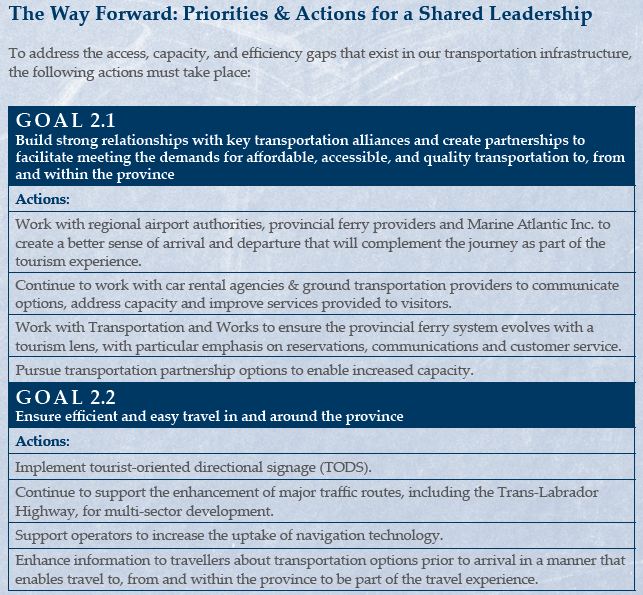Strategic Direction #2
Strategic Direction #2
Sustainable Transport Network
For Newfoundland and Labrador, there’s no such thing as an accidental tourist. It takes deliberate planning and determined effort to visit here.
Transportation issues will always present challenges for the tourism industry, amongst other industries. The very nature of Newfoundland as an island, and Labrador as an enormous, sparsely populated land mass, positions the province as one that will always have to make a concerted effort to address transportation challenges. While gains have been made within Strategic Direction 2, travel to, from, and within the province, whether by sea, air, or road remains constrained by issues of affordability, capacity, infrastructure, and quality.
To compete effectively in an increasingly aggressive global market, we need the ability to bring travellers to the province in an easy, cost-effective, and pleasurable manner – by sea, by air, and by land. Within the tourism industry, there is a greater understanding than ever about the important role of transportation providers as more than just people movers. This broader understanding has enabled movement towards making transportation part of the traveller experience within the Newfoundland and Labrador journey. By making transportation part of the experience, we eliminate the need for everything to be perfect; however, in this case, communication and awareness become even more important. As travellers plan their vacations, it is imperative that they know what their travel options are and have all the information they need to feel comfortable about the reliability and quality of their transportation arrangements.
Although communications and awareness can position transportation options differently, further gains must be achieved if we are to stimulate inbound tourism as a means of growing our industry in the remaining years to 2020.
Access by Air
Air passenger travel accounts for approximately 75% of non-resident visits each year with an increase in air travel being shown year over year. The expansion of St. John’s airport and the addition of routes in various airports throughout the province support the propensity for air travel. Linked to air access, however, is the availability of rental vehicles and ground transportation options, as many of those that travel by air also require additional transportation options once they arrive.
Access by Land & Sea
Recent years have seen a decrease in the number of visitors arriving by sea and road. The cost to travel by ferry to the province is increasing and Marine Atlantic Inc. is experiencing declining passenger traffic. Visitors by sea and road tend to stay longer and spread the benefits of tourism to our rural communities and regions. Ensuring strength in this market segment will require significant coordination of effort from all sectors of government and industry to support the strategic development of our ferry services as one of our most vital links.
In-Province Infrastructure
Well-developed and efficient in-province transportation infrastructure must also complement overall ease of access to our destination. This includes well-maintained roads, adequate road and directional signage, public transport, and other infrastructure to meet the needs of travellers. The maintenance and construction of such infrastructure will always present challenges that require concerted efforts to overcome. Strategic thinking and investment will be required to ensure infrastructure supports the ease of travel within the province and meets visitor needs to support future growth.

